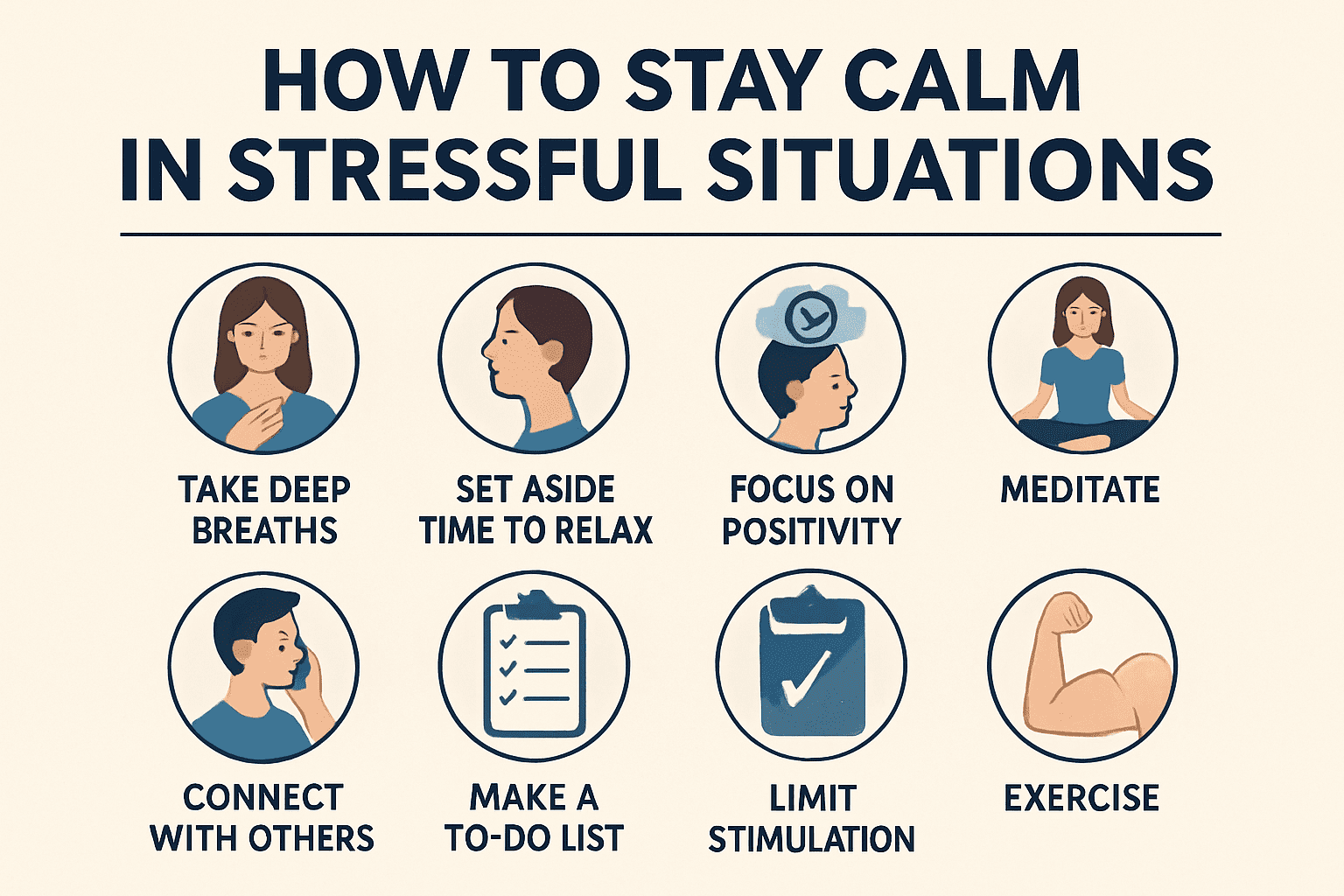How to Stay Calm in Stressful Situations

How to Stay Calm During Stressful Situations: A Complete Guide for Anyone Feeling Overwhelmed
Life throws curveballs at everyone, and knowing how to stay calm during stressful situations can make the difference between feeling completely overwhelmed or staying in control. This guide is perfect for students facing exam pressure, working professionals dealing with tight deadlines, parents juggling multiple responsibilities, or anyone who wants to handle life’s challenges with more grace and less panic.
We’ll start by exploring what stress actually does to your body and mind, so you understand why you react the way you do. Then we’ll dive into quick breathing techniques you can use anywhere – whether you’re stuck in traffic or about to give a presentation – to find instant relief. Finally, we’ll cover simple mental strategies that help you change how you think about stressful moments, plus easy physical habits that keep your stress levels manageable day-to-day.
By the end, you’ll have a toolkit of practical methods to stay centered when things get chaotic, plus strategies for building lasting resilience against future stress.
Understanding the Nature of Stress and Its Impact

Recognize Physical Warning Signs of Stress Buildup
Your body acts like an early warning system, sending clear signals when stress begins to accumulate. These physical indicators often appear before emotional symptoms become overwhelming, making them valuable tools for prevention.
The most common early warning signs include muscle tension, particularly in the neck, shoulders, and jaw. Many people unconsciously clench their teeth or hunch their shoulders when stress builds up. Headaches frequently follow, starting as mild discomfort behind the eyes or at the temples before intensifying.
Sleep patterns shift dramatically under stress. You might find yourself lying awake at night with racing thoughts, or conversely, feeling exhausted despite getting adequate rest. Changes in appetite are equally telling – some people lose their desire to eat entirely, while others turn to comfort foods and overeat.
Physical energy levels fluctuate unpredictably. One day you feel restless and jittery, unable to sit still, while the next brings crushing fatigue that makes simple tasks feel monumental. Digestive issues like stomach knots, nausea, or changes in bowel movements often accompany prolonged stress.
Your heart rate may increase even during calm moments, and you might notice shallow, rapid breathing patterns. Some people develop skin problems, experience frequent minor illnesses due to weakened immunity, or notice changes in their voice pitch or speaking rhythm.
Identify Emotional Triggers That Escalate Tension
Emotional triggers vary greatly from person to person, but recognizing your specific patterns helps prevent stress from spiraling out of control. These triggers often connect to deeper fears, unmet needs, or past experiences that continue to influence your reactions.
Perfectionism ranks among the most common triggers. When you set impossibly high standards for yourself or others, every minor mistake feels catastrophic. The fear of failure creates a constant state of anxiety that amplifies stress in any challenging situation.
Feeling out of control triggers intense stress responses in many people. This might happen during unexpected changes at work, family conflicts you can’t resolve, or situations where others make decisions that affect your life without your input.
Interpersonal conflicts create powerful emotional reactions. Criticism, rejection, or confrontation can instantly elevate stress levels, especially when these situations remind you of painful past experiences. The need for approval and acceptance can make social situations particularly challenging.
Time pressure acts as a universal trigger. Running late, facing tight deadlines, or feeling like there’s never enough time to complete important tasks creates a persistent state of urgency that keeps stress hormones elevated throughout the day.
Financial concerns, health worries, and family responsibilities often combine to create compound triggers. When multiple stressors occur simultaneously, the emotional impact multiplies rather than simply adding up.
Understand How Stress Affects Decision-Making Abilities
Stress fundamentally alters how your brain processes information and makes decisions. When stress hormones flood your system, the prefrontal cortex – responsible for rational thinking and planning – becomes less active while the emotional brain centers take over.
This shift leads to several predictable changes in decision-making quality. You’re more likely to make impulsive choices without considering long-term consequences. The ability to weigh multiple options decreases significantly, and you may find yourself seeing situations in black-and-white terms rather than recognizing nuanced solutions.
Memory function suffers under stress, making it difficult to recall important information when you need it most. You might forget crucial details about ongoing projects, lose track of commitments, or struggle to remember conversations from just hours earlier.
Creativity and problem-solving abilities decline sharply. Stress narrows your thinking to focus on immediate threats, which blocks access to the innovative solutions that often work best in complex situations. You become more likely to rely on familiar but potentially ineffective approaches rather than exploring new possibilities.
Risk assessment becomes skewed under stress. Some people become overly cautious, avoiding necessary decisions entirely, while others swing toward reckless choices that ignore obvious dangers. Both extremes can create additional problems that compound existing stress.
Communication skills deteriorate as stress increases. You may struggle to articulate thoughts clearly, become more reactive in conversations, or misinterpret others’ intentions. These communication breakdowns often create interpersonal conflicts that add new layers of stress to already challenging situations.
Master Quick Breathing Techniques for Instant Calm

Practice the 4-7-8 breathing method for rapid relaxation
The 4-7-8 breathing technique works like a natural tranquilizer for your nervous system. When you feel stress building up, this method can shift your body from fight-or-flight mode to a calmer state within minutes.
Here’s how to do it: Sit comfortably and place the tip of your tongue against the ridge behind your upper teeth. Exhale completely through your mouth, making a whoosh sound. Close your mouth and inhale quietly through your nose for 4 counts. Hold your breath for 7 counts. Exhale through your mouth for 8 counts, making that same whoosh sound.
Start with just 4 complete cycles and gradually work up to 8. The magic happens in the extended exhale – it activates your parasympathetic nervous system and tells your brain that everything’s okay. Many people notice their heart rate slowing down and shoulders dropping within the first few cycles.
Use diaphragmatic breathing to activate your calm response
Your diaphragm is your body’s built-in stress reliever, but most people breathe shallow chest breaths that actually increase anxiety. Diaphragmatic breathing engages your vagus nerve, which directly communicates with your brain to turn down the stress response.
Place one hand on your chest and another on your belly. When you breathe properly, your bottom hand should move more than the top one. Take slow, deep breaths through your nose, expanding your belly like a balloon. Your chest should barely move. Exhale slowly through pursed lips, letting your belly fall naturally.
This type of breathing increases oxygen efficiency and reduces the production of stress hormones like cortisol. Practice this for 5-10 minutes daily when you’re calm, so it becomes automatic during stressful moments.
Implement box breathing during high-pressure moments
Box breathing, also called square breathing, gives your mind something specific to focus on when stress threatens to overwhelm you. This technique is used by Navy SEALs and emergency responders because it works even in extreme situations.
The pattern is simple: breathe in for 4 counts, hold for 4, exhale for 4, hold empty for 4. Imagine drawing a square in your mind as you breathe. Each side of the square represents one part of the cycle.
What makes box breathing so effective during high-pressure moments is its predictable rhythm. Your mind can’t spiral into panic when it’s occupied with counting and following the pattern. Start with 4-count cycles, but you can adjust the timing to what feels comfortable – some people prefer 5 or 6 counts per side.
Create breathing anchors for consistent stress relief
Breathing anchors connect your calm breathing practice to specific triggers or locations, making stress relief more automatic. Think of them as shortcuts to your relaxation response.
Pick physical cues that happen regularly throughout your day – like sitting at red lights, opening your email, or walking through doorways. Every time you encounter these triggers, take three deep diaphragmatic breaths. Your brain will start linking these moments with relaxation.
You can also create mental anchors by pairing your breathing with a calming word or phrase. Some people use “calm” on the inhale and “peace” on the exhale. Others prefer “breathe in strength, breathe out tension.” The key is consistency – use the same anchor words each time.
Visual anchors work too. Imagine breathing in golden light or exhaling dark clouds. These mental images give your mind something soothing to focus on while your breathing does the physiological work of calming your system.
Develop Mental Strategies to Control Your Response

Challenge negative thought patterns with rational thinking
Your brain loves to create stories, especially dramatic ones during stressful situations. The problem? These mental narratives often spiral into worst-case scenarios that have little basis in reality. When stress hits, your mind might jump from “I made a mistake at work” straight to “I’m going to get fired and lose everything.”
Start by catching these thoughts red-handed. The moment you notice your inner voice getting dramatic, pause and ask yourself: “Is this thought actually true?” Look for concrete evidence. If your boss seemed annoyed in a meeting, that doesn’t automatically mean your job is in danger. Maybe they’re dealing with their own pressures.
Create a mental evidence board. Write down the facts versus your assumptions. Often, you’ll discover that your stress comes from fictional scenarios your brain invented. Replace catastrophic thoughts with balanced ones. Instead of “Everything is falling apart,” try “This situation is challenging, but I can handle it step by step.”
Use the pause technique before reacting impulsively
Your first reaction in stressful moments is rarely your best reaction. That surge of emotion wants you to act immediately – send that angry email, raise your voice, or make hasty decisions you’ll regret later.
The pause technique creates a crucial gap between trigger and response. When you feel that familiar stress rising, literally count to ten. Take three deep breaths. This isn’t about suppressing your feelings; it’s about giving your rational mind time to catch up with your emotional brain.
During this pause, ask yourself: “What outcome do I actually want here?” If someone cuts you off in traffic, your immediate impulse might be road rage. But what you really want is to arrive safely at your destination. The pause helps you remember your true priorities and respond accordingly.
Practice this technique during low-stakes situations first. When your coffee order is wrong or someone takes too long at the ATM, use these moments to build your pause muscle. The more you practice during minor irritations, the more automatic it becomes during major stressors.
Practice mental reframing to find opportunity in crisis
Every stressful situation contains hidden possibilities, but your stressed brain focuses only on threats. Mental reframing shifts your perspective from victim to problem-solver, from crisis to opportunity for growth.
Start by asking different questions. Instead of “Why is this happening to me?” try “What can I learn from this?” or “How might this redirect me toward something better?” When you lose a job, the immediate stress is overwhelming. But reframing reveals potential opportunities: time to reassess your career goals, chance to pursue that skill you’ve been putting off, or opening for a better position.
Create a reframing toolkit with specific phrases that work for you. “This is temporary,” “I’ve handled difficult things before,” or “What’s the lesson here?” Keep these ready for when stress clouds your judgment.
The goal isn’t toxic positivity – pretending everything is wonderful when it’s not. Real reframing acknowledges the difficulty while actively searching for constructive angles. It’s the difference between denying a problem exists and choosing to focus on solutions rather than dwelling on the problem itself.
Build emotional distance through third-person perspective
When you’re drowning in stress, it’s nearly impossible to think clearly because you’re too close to the situation. The third-person perspective technique creates psychological distance, allowing you to see your situation with the clarity you’d have when helping a friend.
Instead of thinking “I can’t handle this pressure,” shift to “Sarah is dealing with a lot of pressure right now. What would be helpful for her?” This simple language change activates different parts of your brain – the same ones that kick in when you’re giving advice to others.
Imagine watching your stressful situation unfold in a movie. What would the wise mentor character tell the protagonist? What strategies would work? This mental step back often reveals solutions that were invisible when you were trapped in first-person panic mode.
You can also try the “friend test.” If your best friend came to you with this exact same problem, what would you tell them? Your advice to others is usually much more balanced and practical than the harsh criticism or catastrophic thinking you direct at yourself.
Implement the 10-10-10 rule for better decision making
Stress makes everything feel urgent and permanent. The 10-10-10 rule cuts through this illusion by expanding your time perspective. Before making any significant decision during stress, ask yourself: How will I feel about this choice in 10 minutes, 10 months, and 10 years?
This technique prevents both impulsive reactions and paralysis by analysis. That angry response might feel satisfying in 10 minutes but could damage relationships for 10 months or longer. Conversely, the difficult conversation you’re avoiding might cause 10 minutes of discomfort but solve problems for the next 10 years.
Use different timeframes based on your situation. For daily stressors, try 10 minutes, 10 hours, and 10 days. For major life decisions, extend to 10 years or even longer. The key is breaking free from the immediate emotional intensity that clouds judgment.
The rule also helps prioritize your energy. If something won’t matter in 10 months, maybe it doesn’t deserve the stress you’re giving it right now. Save your mental resources for decisions and situations that will actually impact your long-term well-being and goals.
Create Physical Habits That Support Inner Peace

Use progressive muscle relaxation during tense situations
When stress hits hard, your body tightens up without you even realizing it. Progressive muscle relaxation works by deliberately tensing and then releasing muscle groups throughout your body. Start with your toes – squeeze them tight for five seconds, then let go completely. Notice the contrast between tension and relaxation. Move up through your calves, thighs, abdomen, arms, shoulders, and face.
The beauty of this technique lies in its adaptability. You can do a full-body session in fifteen minutes, or focus on specific areas during brief moments of stress. Feeling tension in your shoulders during a difficult meeting? Discreetly tense and release your shoulder muscles while maintaining normal breathing. Your nervous system gets the message that it’s safe to relax, even when your mind is racing.
Practice this technique regularly when you’re calm, so it becomes second nature during stressful moments. Your muscle memory will kick in automatically, helping you release physical tension before it escalates into overwhelming stress.
Practice grounding techniques to stay present
Grounding anchors you to the present moment when anxiety tries to pull you into future worries or past regrets. The 5-4-3-2-1 technique engages all your senses: identify five things you can see, four you can touch, three you can hear, two you can smell, and one you can taste. This simple exercise interrupts the stress spiral and brings immediate relief.
Physical grounding works just as well. Press your feet firmly into the floor and feel the solid support beneath you. Place your hands on a cool surface like a wall or desk. Hold a small object in your pocket – a smooth stone or textured keychain – and focus on its weight and texture. These tactile connections remind your nervous system that you’re safe in this moment.
Another powerful grounding method involves naming your current experience without judgment. “Right now, I’m sitting in my office chair. My heart is beating fast. I can hear traffic outside.” This simple acknowledgment helps you observe stress rather than become consumed by it.
Maintain proper posture to influence your mental state
Your physical posture directly impacts your emotional state through what researchers call embodied cognition. Slouching forward with rounded shoulders signals defeat to your brain, while an upright, open posture communicates confidence and calm. When stress hits, your natural tendency is to contract inward, but conscious posture adjustment can interrupt this pattern.
Stand or sit with your spine straight but not rigid. Draw your shoulder blades down and back, opening your chest. Keep your chin parallel to the ground. This alignment allows for deeper breathing and sends signals to your brain that you’re in control. Even a two-minute posture adjustment can shift your mental state from anxious to centered.
Practice “power posing” during stressful transitions. Before entering a challenging situation, spend thirty seconds in a confident stance – feet shoulder-width apart, hands on hips, chest open. This simple physical change activates confidence-related hormones and reduces stress hormones like cortisol.
Develop quick movement breaks to release built-up tension
Movement is stress’s natural antidote. When fight-or-flight hormones flood your system, physical activity helps metabolize them effectively. You don’t need a full workout – even thirty seconds of movement can make a significant difference.
Desk-based movements work wonders during busy days. Roll your shoulders backward ten times, then forward. Gently turn your head side to side and up and down. Stand up and do five gentle twists at the waist. These micro-movements prevent tension from accumulating in common stress-holding areas.
For more intense stress relief, try the “shake it off” technique. Starting with your hands, shake them vigorously for ten seconds. Move to your arms, then your whole body. This mimics how animals naturally discharge stress and helps reset your nervous system. Walking, even for two minutes, can also provide immediate relief by engaging your body’s natural rhythm and promoting clearer thinking.
Create movement reminders throughout your day. Set phone alerts for brief stretch breaks, or use transitions between tasks as cues for quick physical resets.
Build Long-term Resilience Against Future Stress

Establish daily meditation or mindfulness practices
Building a daily meditation routine creates the foundation for lasting stress resilience. Start with just five minutes each morning, focusing on deep breathing or body awareness. The key is consistency rather than duration. Your brain literally rewires itself through regular practice, developing stronger neural pathways for calm and clarity.
Mindfulness doesn’t require sitting cross-legged on a cushion. Walking meditation works perfectly while commuting or during lunch breaks. Simply pay attention to your steps, breathing, and surroundings without judgment. Apps like Headspace or Calm can guide you initially, but eventually you’ll develop your own rhythm.
Progressive muscle relaxation offers another powerful approach. Tense and release each muscle group from your toes to your head, teaching your body to recognize and release physical tension. This technique becomes invaluable during stressful moments when you need quick relief.
Create personal stress management toolkits
Your toolkit should contain specific strategies that work for your unique personality and lifestyle. Some people respond well to vigorous exercise, while others prefer gentle yoga or stretching. Experiment with different approaches and note what actually helps you feel calmer.
Include both immediate relief techniques and longer-term strategies. Quick fixes might include essential oils, calming music playlists, or specific mantras you can repeat. Longer-term tools could involve journaling prompts, hobby activities, or creative outlets that help you process emotions.
Keep digital versions on your phone and physical items in your car, office, and bedroom. When stress hits, you won’t have the mental energy to remember all your options. Having them readily available makes the difference between using them and suffering through the moment.
| Quick Relief Tools | Longer-term Strategies |
|---|---|
| Deep breathing exercises | Regular exercise routine |
| Calming music or sounds | Journaling practice |
| Essential oils | Creative hobbies |
| Positive affirmations | Nature activities |
| Cold water on face/hands | Reading or learning |
Strengthen your support network before crisis hits
Strong relationships act as stress buffers, but they need cultivation during calm periods. Reach out to friends and family regularly, not just when you need help. Share positive experiences, offer support to others, and maintain meaningful connections through consistent communication.
Professional support matters too. Find a therapist, counselor, or coach before you desperately need one. Many people wait until they’re overwhelmed to seek help, but building these relationships during stable times creates a safety net for future challenges.
Consider joining groups aligned with your interests or values. Book clubs, fitness groups, volunteer organizations, or professional associations provide multiple connection points. These relationships often prove surprisingly supportive during difficult times because they’re built around shared experiences and common ground.
Don’t forget about mentors or role models who’ve navigated similar challenges. Their perspective and guidance can provide invaluable insights when you’re facing your own stressful situations.
Develop realistic expectations and acceptance strategies
Perfectionism fuels stress by creating impossible standards. Practice setting achievable goals and celebrating progress rather than demanding flawless outcomes. This shift in mindset reduces daily pressure and builds confidence in your ability to handle challenges.
Learn to distinguish between what you can and cannot control. Focus your energy on your responses, decisions, and actions rather than trying to control external circumstances or other people’s behavior. This fundamental shift dramatically reduces stress and increases your sense of personal power.
Acceptance doesn’t mean giving up or becoming passive. It means acknowledging reality without adding emotional resistance that intensifies suffering. Practice phrases like “This is difficult, and I can handle it” or “I don’t like this situation, and I’ll work with what I have.”
Build flexibility into your plans and expectations. Life rarely goes exactly as planned, so developing comfort with uncertainty and change prevents stress from derailing your peace of mind. Create backup plans and maintain a problem-solving mindset rather than a crisis mindset when things don’t go as expected.

Staying calm when everything around you feels chaotic isn’t about being superhuman – it’s about having the right tools in your toolkit. Deep breathing, mental reframing, and physical habits like regular exercise or meditation can transform how you handle pressure. These aren’t just feel-good activities; they’re practical strategies that actually change how your brain responds to stress.
The real game-changer happens when you start building these practices into your daily routine, not just when crisis hits. Think of it like training for a marathon – you don’t wait until race day to start running. Start with just five minutes of breathing exercises or a short walk when you feel tension building. Your future self will thank you when the next stressful situation comes around, and you find yourself responding with clarity instead of panic.

1 thought on “How to Stay Calm in Stressful Situations”